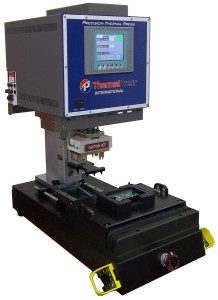Plastic Assembly Process Options for Particulate-Free Results
 Clean and reliable plastic bonding is critical to a broad range of industries. From automotive shops to medical supply manufacturers, plastic assembly tools are a common sight on many factory floors.
Clean and reliable plastic bonding is critical to a broad range of industries. From automotive shops to medical supply manufacturers, plastic assembly tools are a common sight on many factory floors.
Being such an in-demand process among different industries, it stands to reason that there are many ways to bond plastic parts to one another. Some of the most popular options include:
- Ultrasonic Welding
- Spin Welding
- Vibration Welding
- Thermal Staking
There are no one size fits all solutions to plastic assembly. To identify the most effective process for your factory floor, you must determine the most important elements of your manufacturing process as a whole.
In the medical and food industries, for example, particulate residue is a dominating factor. The FDA sets strict standards for particulate contamination in food packaging in Title 21, section 177 of the Code of Federal Regulations (CFR). If you implement a plastic joining process for a product in this industry, you need a particulate-free joining process that is reliable, repeatable, and versatile.
Particulate Regulation: How Do Common Plastic Welding Processes Compare?
If you operate in the food, beverage, cosmetic, or medical industries, your manufacturing process must be compliant with Federal particulate regulation. Plastic contaminants can make their way from containers to products, eventually making their way into consumers’ bodies.
Consider the particulate residue factors of the four abovementioned plastic welding processes:
1. Ultrasonic Welding
Ultrasonic welding creates plastic bonds using a piezo-electric mechanism. The tool converts electric current into high frequency mechanical motion that welds plastic parts together in a controlled manner. While ultrasonic welding is common in the medical supply industry, it can produce particulate matter when plastic joints are not properly calibrated and aligned.
2. Spin Welding
A spin welding machine holds one part stationary while another is spun at high speed. The two parts are then conjoined – friction generates heat that welds the two parts together. Spin welding is commonly used to create insulated bowls, filter housings, and conjoined pipes. It generates a great deal of particulate matter and flash – melted material pushed out of the weld joint. This makes it totally unsuitable for medical or food applications.
3. Vibration Welding
Common to the auto industry, manufacturers typically use vibration welding to weld large parts together – vehicle headlamps and taillights, for example. In practice, the process is similar to ultrasonic welding and spin welding but typically occurs on a larger scale. However, it generates significant amounts of flash and particulate matter, which can contaminate finer products.
4. Heat Staking
A properly calibrated heat staking machine produces no particulate matter. The machine mechanically bonds two plastic parts by melting plastic posts using localized heat. Since the process minimizes friction and mechanical movement, it eliminates flash and particulate residue. However, poorly calibrated heat staking machines can cause thermal sticking – leaving behind stringy wisps of plastic at the joint.